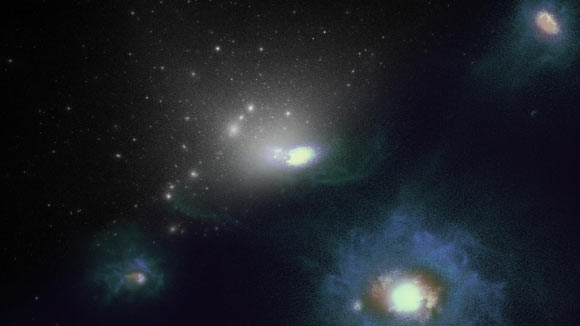Milky Way Captured Few Dwarf Galaxies from Nearby Large Magellanic Cloud | Astronomy – Sci-News.com
Our Milky Way Galaxy is orbited by more than 50 companion galaxies. According to new research led by University of California, Riverside astronomers, several of these tiny galaxies were captured from an orbit around the Large Magellanic Cloud (LMC), a small galaxy located 160,000 light-years away.

A simulated Large Magellanic Cloud-like galaxy with stars and gas, and several smaller companion galaxies. Image credit: Ethan Jahn, University of California, Riverside.
“Our results are an important confirmation of our cosmological models, which predict that small dwarf galaxies in the Universe should also be surrounded by a population of smaller fainter galaxy companions,” said co-author Dr. Laura Sales, an astronomer in the Department of Physics and Astronomy at the University of California, Riverside.
“This is the first time that we are able to map the hierarchy of structure formation to such faint and ultrafaint dwarfs.”
Dr. Sales and colleagues made the discovery by using data gathered by ESA’s Gaia satellite on the motions of several nearby galaxies and contrasting this with state-of-the-art cosmological hydrodynamical simulations.
The astronomers used the positions in the sky and the predicted velocities of material, such as dark matter, accompanying the LMC, finding that at least four ultrafaint dwarfs and two classical dwarfs, Carina and Fornax, used to be satellites of the LMC.
“Through the ongoing merger process, however, the more massive Milky Way used its powerful gravitational field to tear apart the LMC and steal these satellites,” they said.
The team used computer simulations from the Feedback In Realistic Environments (FIRE) project to show the LMC and galaxies similar to it host numerous dwarf galaxies, many of which contain no stars at all — only dark matter.
“The high number of tiny dwarf galaxies seems to suggest the dark matter content of the LMC is quite large, meaning the Milky Way is undergoing the most massive merger in its history, with the LMC, its partner, bringing in as much as one third of the mass in the Milky Way’s dark matter halo,” said first author Ethan Jahn, a graduate student at the University of California, Riverside.
“The number of tiny dwarf galaxies the LMC hosts may be higher than astronomers previously estimated, and that many of these tiny satellites have no stars.”
“Small galaxies are hard to measure, and it’s possible that some already-known ultrafaint dwarf galaxies are in fact associated with the LMC.”
“It’s also possible that we will discover new ultrafaints that are associated with the LMC.”
Dwarf galaxies can either be satellites of larger galaxies, or they can be isolated, existing on their own and independent of any larger object.
“The LMC used to be isolated, but it was captured by the gravity of the Milky Way and is now its satellite,” Jahn said.
“The LMC hosted at least seven satellite galaxies of its own, including the Small Magellanic Cloud in the Southern Sky, prior to them being captured by the Milky Way.”
The study appears in the Monthly Notices of the Royal Astronomical Society.
_____
Ethan D. Jahn et al. 2019. Dark and luminous satellites of LMC-mass galaxies in the FIRE simulations. MNRAS 489 (4): 5348-5364; doi: 10.1093/mnras/stz2457






